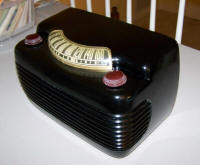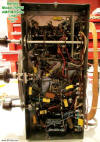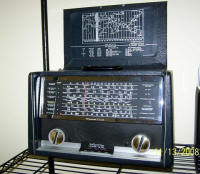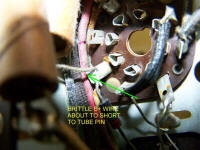|
 At the left is a photo of a
1941 Crosley Model 03CB floor model radio. This one I restored
a couple years ago, but I restored another one 20-some years ago, which was given
as a wedding present to my sister-in-law (Melanie's sister). At the left is a photo of a
1941 Crosley Model 03CB floor model radio. This one I restored
a couple years ago, but I restored another one 20-some years ago, which was given
as a wedding present to my sister-in-law (Melanie's sister).
Robin Sparkes just checked in with a
Capehart Radio restoration project that he is getting ready to
undertake. Please click on the link to view his page. Maybe you can provide some
assistance.
You will also want to check out Gary Steinhour's restored
Hammarlund Mfg. RBG-2 and
Scott Radio Labs RBO-2 Navy radios.
Here is a page of links to companies that provide
restoration services and parts.
Paul's Tube Radio Restoration
website has lots of good photos of restoration processes.
Bob Davis' Radio Restorations
RF Cafe visitor Bob Davis, whom I have known for many years, recently sent me
(at my request) photos of some of the antique radios that he has restored - it is
one of his hobbies. That these radios are still available is a bit miraculous since
Bob lives in New Orleans, very near the levee system along Lake Pontchartrain. Fortunately,
his home was on higher ground and was spared the worst of the flooding during Katrina.
Here are Bob's restoration stories for his
Midland and
Lloyds shortwave radio, his RCA 86T, and a few other
radio restoration
projects. Here is very nice DIY
radio chassis work fixture Bob designed and built.
RCA 86T Restoration Project
RCA 86T


This is a really nice, art deco looking set. I got it from a friend. It's on
the list to restore, but haven't found a really good schematic for it. I turned
it on so you could see the dial. It hums a bit, so I'm worried that the caps may
blow up.
Read Bob's complete write-up on the 86T restoration project.
My Christmas [2008] holiday project was to start restoring my RCA 86T radio.This
fellow came to me through a friend of a friend as a forewarned basket case. For
the 50 bucks I gave him for it, I didn't care what I had to do to it (at the time
my car took more than 50 bucks to fill up!).
I took a few pictures showing the dangers of just connecting one of these old
fellows up to the AC mains and going for it (they were on a current limited power
supply, with one hand holding the camera and the other poised over a kill switch).
I wonder how many people buy these old sets off of the internet or antique shops
and are told they are "re-capped" and ready to go without such obvious hazards like
these repaired? Heat and rubber coated wire + 70 years = fire! Cloth covered wire
gets brittle too, as one of the pictures show.
There are many businesses where competent folks sell radios that are refurbed
safely (and professionally). Some auction sellers One will find on the popular sites
are amongst that number. Be careful to check credentials and get a few referrals
before you buy unless you're going to gut and rebuild the radio yourself. The pro's
will be happy to show off their work, with pride. Whatever one does, a disassembly
and a safety check beneath the chassis of any old set one may buy is good advice
before plugging it into the wall. It may be pretty on the outside and not be so
pretty underneath the chassis.
Airline 62-437 "Movie Dial"
 
Here is an Airline 62-437 "Movie Dial" tabletop radio from the series that was
sold by Montgomery Ward in the 1930s. It uses a
self-rectifying vibrator DC-DC converter for changing 6 Vdc to
145 Vdc. See a complete article on the restoration
here.
 Stewart Warner R1451-A Stewart Warner R1451-A

This is a wonderful set, circa 1936. It has been fully restored. The magic dial
glows in the dark ready to navigate the user around the world. It has a wonderful
tone and is a real DX hound.
Philco 46-420
 Post WW2, late 1940's. This set is a little
unique. Most you will see have the 8 pin 50L6 output tube. This one uses a 50B5
which is a newer mini tube amongst the locking 7 volt filament tubes (fun to get
those out of the sockets). This unit came to me in a shopping bag with about 5 coats
of various types of white paint on it and many insect nests in it. Every wire in
it had to be replaced as they all crumbled when I flexed them. About 100 hours in
this little girl. I stripped off all the paint to reveal a beautiful, "swirly" cabinet. Post WW2, late 1940's. This set is a little
unique. Most you will see have the 8 pin 50L6 output tube. This one uses a 50B5
which is a newer mini tube amongst the locking 7 volt filament tubes (fun to get
those out of the sockets). This unit came to me in a shopping bag with about 5 coats
of various types of white paint on it and many insect nests in it. Every wire in
it had to be replaced as they all crumbled when I flexed them. About 100 hours in
this little girl. I stripped off all the paint to reveal a beautiful, "swirly" cabinet.
You can still pick these up on eBay once in a while for under $100.00 (make sure
you restore them or they have been restored if you want a player, their wiring and
their capacitors don't age well). This one probably isn't worth the $300 some of
them go for totally restored, but it was owned by my Uncle Pete and it was the first
radio I remember that could get AM stations in Iowa that were farther away than
any other radio I had access to at 6 years old. Let's just say it HAD to be restored
as it helped to launch a long career of yours truly making sensitive receivers for
a living.
They call these "Hippopotamus" radios, one can see why with a quick look at the
face.
Bendix Model 75P6U AM/FM 
"A late 1940's Bendix AM/FM set. Now that she's all re-capped and re-tuned it's
a very nice receiver. Look at how labor intensive the wiring is underneath. This
one would have survived a Russian attack for sure... I still have a little cabinet
work to do. Trying to find a good pinstripe brush to re-do the frequency dial where
the paint wore off after 60+ years."
 Crosley Desktop Model Crosley Desktop Model
This is the next challenge for restoration. Say...where's the FM dial?
 Stewart Warner SW13-6P1 Stewart Warner SW13-6P1
Nice little set. Dual band unit pre WW2. Best I can tell from what I've seen
it was around 1939. I'm sure someone will tell me exactly (the Riders diagram on
this one doesn't have a date).
Capehart TC-62
 One black, one white. The black one is totally
restored (note the "Saints" colors?). One black, one white. The black one is totally
restored (note the "Saints" colors?).
I had one of these when I was a kid and it was an AM DX hound. The TC-62 had
a extra tube in it for an RF amp over the other, cheaper set that looked identical
to it. The tube wasn't too well shielded however and the radio would squeal if you
got the signal strength and the tuning cap just right (which was pretty cool to
a 7 year old). Neither of these have that issue as I shielded the tubes.
I like these not only because they remind me of the one I had (that my Dad gave
to me when it was retired from the kitchen counter) when I was a kid, but they also
have some nice 1950's styling. These are circa 1954.
 Hallicrafters TW-1000A Hallicrafters TW-1000A
I bought this on eBay and brought it back to life thanks to the BAMA site I see
you have a link to on your site now (wow, great folks who provide the schematics
for us). I went through it with a fine tooth comb and refurbed all the electronics
with new caps etc. and then did a full re-alignment on it using my fancy test equipment.
It's a real player and a fine shortwave set. If you look, there is quite a bit of
band spread across the dial (i.e. the frequency change versus dial travel is small),
makes it really nice to DX with.
Bob says: "I'll probably have a really neat one for you in about 3 months Once
I get it restored. It uses a projection system to display the station Information,
they call it a 'movie dial'.
If you take this further, perhaps a warning on your hobby page that if you buy
one of these things (especially off of eBay) have it inspected by a qualified tech
or rebuild it yourself Or you may burn the house down. I don't quite know how one
would word that, but It's probably a good idea. Old caps explode, old cords are
frayed and short, transformers short And the insulation starts on fire, you know,
cool stuff! Also a note about knowing what you are doing, using an isolation transformer
and variac so you don't kill yourself or set off an explosion hitting 70 year old
caps with a 120 volt (or higher) transient by just plugging the radio, in may be
an idea.
I worked on an old Aetna radio a few years back and the IF cans had 200 volts
on them, ouch!"
Here are some pictures of some of the radios I have. All but the White Capehart
and the Wards Magic Dial have been gone through thoroughly although I haven't done
the full cabinet restoration on most.
I usually concentrate on the insides and bring them back to life and make them
safe. I leave the cabinet collecting to the collectors. I just do this for fun,
and to re-learn some of the old secrets the RF engineers of the past used to make
these radios use fewer parts but still perform so well.
I will say it is fun to tune them up with my Rohde and Schwarz test equipment.
The engineers who designed these never could have foreseen a 7 GHz spectrum
analyzer and a 3 GHz high fidelity signal generator aligning their sets I am
sure.
Well, that's about it for now, I have a few hangar queens that I'm working on,
namely a 1936 Wards (Wells Gardner) "Movie Dial" set and a 1931 Westinghouse/Philco
grandfather clock radio. Both are real basket cases, but will soon be back in shape.
I hope you found this interesting.
 This 1941* Crosley floor console radio
model 03CB
was given to me as a Christmas present in 1983 by my wife, Melanie. It was found
by my sister, Gayle, and her husband, Mike, in a barn on Kent Island on the Eastern
Shore of Maryland. It sported a couple shortwave bands and AM (no FM in those days).
Unfortunately, I did not take any detailed pictures of the unit, so the best I could
come up with is this shot of my two children (Philip & Sally) sitting with my
father-in-law, Marlet Goodwin, on Christmas day of 1990.
|

"The Rainbow of Sound" - Here is a 1942 vintage magazine advertisement pitching
the Crosley Glamor-Tone Radio and Phonograph Combinations. They were the next iteration
of my 1941 version 03CB console radio.
|
Its original finish was peeling off, and all the metal parts - the dial and trim
plates, electronics chassis, etc., was rusting. It sat in our house for a couple
years and then I tackled the refinishing project. Every bit of of the stain and
shellac was removed from the case, and paint from the metal parts, using naval jelly
(the good, caustic pink stuff). Hours of scraping, filling and sanding took care
of the wood, and then a Minwax stain was applied, with a top coat of a few coats
of Deft lacquer. The dial was carefully cleaned and lacquered. The dial trim plate
was primed and painted gold (the original color). I removed all the tube and primed
and painted the chassis gray (its original color). All the paper capacitors were
replaced, and the tubes were tested on a portable tube tester that had been given
to me by überengineer Jim Wilson. Only a couple needed replacing. Those were the
days before eBay and the Internet, so finding replacements took enlisting the help
of Ham friend who found them at a Hamfest. The antenna was a solid rectangular coil
that ran around the rear outside edge of the entire chassis.
After doing a good visual and continuity check of the electronics, I plugged
the radio into the wall. No smoke - that was a good start. A beautiful warm glow
appeared at the base of all the tubes, and before long there was a welcoming 60 Hz
hum coming through the huge electromagnetic speaker (no permanent magnet). I turned
the dial and, voila!, the local AM stations came in clear as a bell (well, as a
bell with a 60 Hz hum). The hum was eventually tamed by adding a couple caps
across the coil. It probably killed some of the bass, but who would notice on AM?
I pushed the "Japan" button and picked up some foreign station, but it definitely
was not from Japan. Similarly, other far away broadcasts were received on the other
bands, but I cannot recall the details.
Melanie and I gave the radio to her sister as a wedding present in 1993, since
her sister's home was decorated in a Victorian theme. It has since, shall we say,
"moved on," and I now have no idea where it resides. Oh well, that's the risk I
took in gifting it. Here are a few of my other
projects.
* I originally had 1926 as the year since I remember seeing the date on
a label inside the radio, but research has shown that it is most likely 1 1941 model.
The 1926 date was probably for one of the patents listed.
Related Pages:
- Crosley 03CB Floor Console Radio by
Adam Guha - 1941 Crosley
03CB Floor Console Radio Restoration Project
-
Radio Chassis Work Fixture -
Tesslor R-601S Vacuum Tube Radio Teardown -
Tesslor R-601S Retro Vacuum Tube AM/FM Radio w/Bluetooth 3.0 Modification
- Crosley 03CA Floor Console Radio for Sale
- 1941 Crosley Model 03CB Radio Photos (Tim
O.) - Radio &
Electronics Restoration Projects -
Vintage Ads
with Science / Technology Themes -
Vintage Magazine Ads
from Duke University's Ad*Access Website -
Vintage Radio Control
Systems
|


























